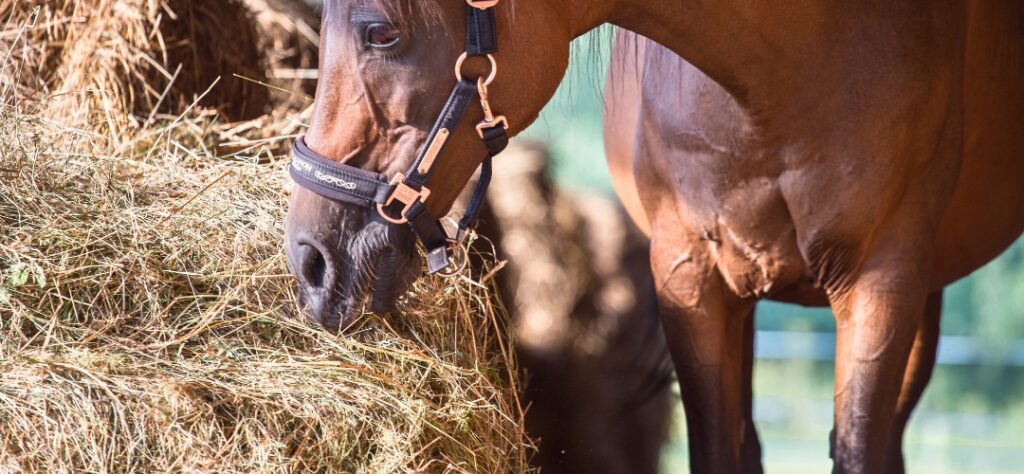Should you test hay for mineral deficiencies? It’s an important question for anyone in the agricultural or equestrian industry. Hay is a staple food source for many animals, and its quality can greatly impact overall health and well-being. While hay might seem like a simple and straightforward feed option, it can sometimes lack essential minerals that are crucial for maintaining optimal nutrition. In this article, we will explore the reasons why testing hay for mineral deficiencies is necessary and the different methods available to ensure that your animals are getting the nutrition they need.
Testing Hay for Digestible Energy
One of the primary reasons why you should test hay for mineral deficiencies is to assess its digestible energy content. Digestible energy is the amount of energy that can be derived from a food source and utilized by the animal’s body. By testing hay for digestible energy, you can determine whether it provides enough calories to meet the animals’ energy requirements.
It is important to note that the digestible energy content of hay can vary significantly depending on factors such as the plant species, maturity at harvest, and weather conditions during the growing season. By testing hay for digestible energy, you can have a better understanding of its nutritional value and adjust the animals’ diet accordingly.
When it comes to assessing the digestible energy content of hay, it is crucial to consider the plant species. Different plant species have varying levels of digestible energy. For example, legume hays such as alfalfa tend to have higher digestible energy content compared to grass hays. This is because legumes have a higher protein content, which contributes to increased energy availability.
Furthermore, the maturity of the hay at harvest plays a significant role in its digestible energy content. As plants mature, their fiber content increases, making it more difficult for animals to extract energy from the hay. Therefore, hay that is harvested at an earlier stage of maturity generally has higher digestible energy content compared to hay that is harvested later.
Weather conditions during the growing season can also impact the digestible energy content of hay. For instance, drought conditions can lead to reduced plant growth and lower nutrient content in the hay. On the other hand, favorable weather conditions with adequate rainfall and sunlight can promote optimal plant growth, resulting in higher digestible energy content.
By testing hay for digestible energy, you can gain valuable insights into its nutritional composition. This information allows you to make informed decisions about the animals’ diet and ensure that their energy requirements are met. Adjusting the animals’ diet based on the digestible energy content of the hay can help optimize their performance, whether it is for growth, reproduction, or maintenance.
Testing hay for digestible energy is essential for assessing its nutritional value and ensuring that it meets the animals’ energy requirements. Factors such as plant species, maturity at harvest, and weather conditions during the growing season can significantly influence the digestible energy content of hay. By considering these factors and adjusting the animals’ diet accordingly, you can provide them with a balanced and nutritious diet that supports their overall health and well-being.
Testing Hay for Dietary Deficiencies
When it comes to the nutritional well-being of animals, testing hay for mineral deficiencies is a crucial step. While hay is generally regarded as a reliable source of nutrition, it may not always contain adequate levels of all essential minerals required by animals.
One of the key minerals to consider is calcium. This mineral plays a vital role in the development and maintenance of strong bones and teeth in animals. Without sufficient calcium in their diet, animals may experience issues such as weak bones, dental problems, and even difficulty in giving birth. By testing hay for calcium deficiencies, you can ensure that the animals receive the necessary amount of this essential mineral.
Phosphorus is another mineral that should not be overlooked. It is involved in various physiological processes, including energy metabolism, cell growth, and the formation of DNA and RNA. A deficiency in phosphorus can lead to poor growth, muscle weakness, and reduced fertility in animals. By testing hay for phosphorus deficiencies, you can address any imbalances and provide the animals with the optimal levels of this vital mineral.
Potassium is yet another mineral that must be considered when testing hay. It plays a crucial role in maintaining proper fluid balance, nerve function, and muscle contractions in animals. A deficiency in potassium can result in muscle weakness, irregular heartbeat, and even paralysis. By testing hay for potassium deficiencies, you can ensure that the animals’ diet is supplemented with the appropriate amount of this essential mineral.
Magnesium is also an essential mineral that should not be overlooked. It is involved in numerous biochemical reactions in the body, including energy production, muscle function, and nerve transmission. A deficiency in magnesium can lead to muscle tremors, poor appetite, and even seizures in animals. By testing hay for magnesium deficiencies, you can identify any imbalances and provide the animals with the necessary amount of this vital mineral.
By testing hay for dietary deficiencies, you can take proactive steps to address any imbalances and ensure that the animals receive a well-rounded and nutritionally balanced diet. This not only promotes their overall health and well-being but also helps prevent potential health issues that may arise from mineral deficiencies.
Testing Hay for Protein Levels
Protein is a crucial nutrient for the growth, repair, and maintenance of body tissues. It plays a vital role in the development of muscles, organs, and enzymes. While hay is not typically known for its high protein content, it is important to test it for protein levels, especially if it serves as a primary or sole source of nutrition for the animals.
The protein content of hay can vary significantly depending on various factors such as the plant species, maturity at harvest, and storage conditions. Different plant species have different protein concentrations, with legumes generally having higher protein content compared to grasses. Additionally, the stage of growth at which the hay is harvested can impact its protein levels. Younger plants tend to have higher protein content, as protein synthesis is more active during the early stages of growth.
Storage conditions can also affect the protein content of hay. Exposure to moisture, heat, and sunlight can lead to protein degradation, reducing its overall nutritional value. Therefore, testing hay for protein levels becomes crucial to ensure that the animals are receiving an adequate amount of protein to support their metabolic functions and overall well-being.
There are various methods to test hay for protein levels. One commonly used method is the Kjeldahl method, which involves digesting the hay sample with sulfuric acid and then distilling the resulting solution to measure the nitrogen content. Since proteins contain approximately 16% nitrogen, the nitrogen content can be used to estimate the protein content of the hay. Another method is near-infrared reflectance spectroscopy (NIRS), which uses light absorption to determine the protein content of the hay sample.
Regularly testing hay for protein levels is essential for livestock owners and farmers to make informed decisions about animal nutrition. By knowing the protein content of the hay, they can adjust the animals’ diet accordingly, supplementing with additional protein sources if necessary. This ensures that the animals receive a balanced diet and helps prevent protein deficiencies, which can lead to poor growth, reduced milk production, and compromised immune function.
While hay may not be renowned for its high protein content, testing it for protein levels is crucial for animal health and well-being. Understanding the factors that influence protein content, such as plant species, maturity at harvest, and storage conditions, can help farmers and livestock owners make informed decisions about animal nutrition.
Testing Hay for Fiber Content
Fiber is an essential component of an animal’s diet, particularly for herbivores such as horses and cattle. Hay is known for its high fiber content, which aids in gut health, digestion, and the prevention of digestive disorders.
However, the fiber content of hay can vary depending on factors such as plant species, maturity at harvest, and storage conditions. By testing hay for fiber content, you can determine whether it meets the animals’ dietary requirements and helps maintain a healthy digestive system.
When it comes to testing hay for fiber content, there are several methods that can be employed. One common technique is the use of a fiber analyzer, which measures the amount of crude fiber present in the hay sample. This method involves boiling the hay in a solution of sulfuric acid and sodium hydroxide, which breaks down the non-fibrous components of the plant material. The remaining fibrous material is then weighed and expressed as a percentage of the original sample weight.
Another method of testing hay for fiber content is the use of near-infrared spectroscopy (NIRS). This technique involves shining a beam of near-infrared light onto the hay sample and measuring the amount of light that is absorbed or reflected. Different types of molecules, including fiber, absorb and reflect light in different ways, allowing scientists to determine the amount of fiber present in the sample.
In addition to measuring crude fiber content, it is also important to consider the digestibility of the hay. Not all fiber is created equal, and some types of fiber are more easily digested by animals than others. To determine the digestibility of hay, researchers may use techniques such as in vitro digestibility assays or feeding trials with animals. These methods provide valuable information about how well the hay will be utilized by the animal’s digestive system.
Testing hay for fiber content is not only important for ensuring that animals receive the necessary nutrients for optimal health, but it can also help farmers and livestock owners make informed decisions about their feeding programs. By knowing the fiber content of the hay, they can adjust the animals’ diets accordingly, ensuring that they receive the appropriate amount of roughage to maintain a healthy digestive system.
Furthermore, testing hay for fiber content can also be beneficial for hay producers. By knowing the fiber content of their hay, they can market it more effectively to potential buyers. For example, hay with a higher fiber content may be more desirable for certain types of livestock or for animals with specific dietary needs.
Try Equi-Safe as a safe solution for horses with nutritional forage deficiencies and digestive health.

Testing Hay for Starch and Sugar Content
Starch and sugar content in hay can be a concern for animals with certain health conditions, such as insulin resistance or metabolic disorders. High levels of starch and sugar in hay can lead to weight gain, laminitis, and other issues.
Testing hay for starch and sugar content can help you identify hay varieties that are suitable for animals with specific dietary needs. This testing allows you to make informed decisions when selecting hay to ensure the animals’ health and prevent any adverse effects related to starch and sugar intake.
When it comes to testing hay for starch and sugar content, there are several methods available. One commonly used method is the Near-Infrared Reflectance Spectroscopy (NIRS) analysis. This technique uses light absorption and reflection to determine the chemical composition of the hay sample.
The NIRS analysis works by shining a beam of light onto the hay sample and measuring the amount of light that is absorbed and reflected. Different chemical compounds, such as starch and sugar, have unique absorption and reflection patterns, allowing the NIRS machine to calculate their concentrations in the hay.
Another method for testing hay is the wet chemistry analysis. This method involves extracting the starch and sugar from the hay sample and then quantifying their concentrations using various chemical reagents and laboratory equipment.
Wet chemistry analysis requires more time and resources compared to NIRS analysis, but it provides more accurate and detailed results. It is often used as a confirmatory test when the NIRS analysis yields unexpected or questionable results.
Once the hay samples have been tested for starch and sugar content, the results are typically expressed as a percentage. This percentage represents the proportion of starch and sugar in the hay sample relative to its total weight.
Based on the test results, you can then determine which hay varieties are suitable for animals with specific dietary needs. Hay with low starch and sugar content is generally recommended for animals with insulin resistance or metabolic disorders, as it helps to maintain stable blood sugar levels and prevent weight gain.
It’s important to note that hay quality can vary depending on factors such as the type of grass or legume, growing conditions, and harvesting methods. Therefore, regular testing of hay batches is essential to ensure consistency in starch and sugar content.
Testing hay for starch and sugar content is crucial for animal owners and caretakers who want to provide the best possible nutrition for their animals. By identifying hay varieties with low starch and sugar content, you can help prevent health issues and promote overall well-being in animals with specific dietary needs.
While hay may appear to be a basic feed option, it is crucial to recognize that it can vary significantly in nutritional content, and deficiencies in minerals and other essential nutrients may occur. Testing hay for mineral deficiencies, digestible energy, protein levels, fiber content, and starch and sugar content provides valuable insights into the nutritional value of the feed. By conducting these tests, you can make informed decisions about the supplementation and dietary management of your animals, ensuring their overall health and well-being.


